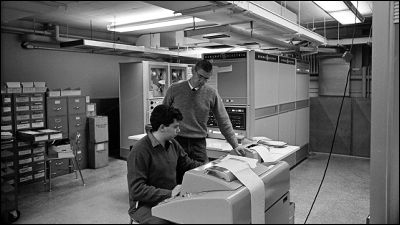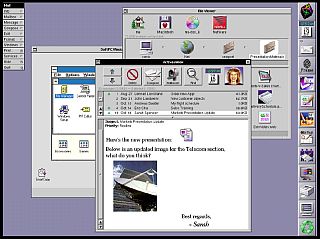The secret story of the birth of 'Visual Basic' developed by Microsoft and boasting tremendous popularity for a while

The programming language `` Visual Basic '' developed by Microsoft was at the peak of popularity for a while, but at the time of writing the article, it has become an inconspicuous existence. About the rise and fall of such Visual Basic, Retool, who develops coding assistance applications, explains with the experiences of Mr. Alan Cooper, who is known as 'the father of Visual Basic'.
Something Pretty Right: A History of Visual Basic | Retool
https://retool.com/visual-basic/
Visual Basic is a language that started with Microsoft buying the programming language 'Ruby' developed by Mr. Cooper. According to Cooper, the development of 'Tripod', the predecessor of Ruby, began in 1985. Windows at the time had a graphical user interface (GUI), but its GUI was much poorer than its rival Macintosh. Therefore, Mr. Cooper started developing a mechanism to greatly enhance the GUI environment of Windows.

The development for improving the GUI did not proceed as expected. However, when Mr. Cooper attended a business meeting between Microsoft and the major bank 'Bank of America' in 1987, the person in charge of Bank of America said, 'From a highly skilled system administrator to a teller We need to make Windows available to all employees, even those who are new to computers.' Mr. Cooper, who heard this remark, said, ``Instead of providing the 'ideal UI' to the developer, 'the parts of the UI' are provided, and the developer combines the parts to create the 'ideal UI' according to the situation. I come up with the idea of 'making a
Mr. Cooper proceeded with the development of Tripod based on the above idea, and created a system that can create a UI by combining parts such as 'buttons', 'lists', and 'lists that display the contents of directories'. Parts such as ``buttons'' and ``lists'' are generally called ``controls'' at the time of article creation, but Mr. Cooper said that he called them ``Wold'' after the nickname of the remote manipulator . However, development collaborator Michael Geary changed the name to ``gizmos (meaning props, small machines, etc.)'' as ``The name ``Wold'' is too difficult. After that, 'gizmos' was changed to 'control' by Microsoft, and it became a name that continued until the time of article creation.
The control developed by Mr. Cooper had functions that lead to modern GUIs such as 'drag and drop' and 'animation'. In addition, there was also a built-in function that 'executes specific code when the user takes an action such as'clicking a button''. While trying to come up with a name for this code-execution feature, Mr. Geary frustratedly fired a rubber band gun at the monitor screen and lit a lighter to smoke a cigar. He said. And Mr. Cooper said that a development term that has been used to the present day, 'fire an event', has emerged in his head.
Then, in 1988, Mr. Cooper had the opportunity to introduce Tripod to Microsoft employees. As soon as the employee confirmed Tripod's function, he said, 'You have to meet Bill Gates,' and arranged a meeting with Mr. Gates in haste. At this time, the person who set up a meeting with Mr. Gates for Mr. Cooper was Mr. Gabe Newell, who later established Valve to develop the game platform 'Steam'.
Mr. Gates, who was shown Tripod by Mr. Cooper, seems to have noticed the charm of Tripod in an instant. During the meeting, a Microsoft employee who was present with Mr. Gates pointed out the defects of Tripod, but Mr. Gates liked Tripod so much that he even defended Tripod on behalf of Mr. Cooper. . Mr. Gates signed a contract with Mr. Cooper and asked for Tripod to be incorporated into 'Windows 3.0' scheduled to be released in 1990.
Cooper needed to refine the Tripod code for Windows 3.0, so he renamed the project 'Ruby' and rewrote most of the code. In addition, Ruby has added 'the ability for third-party developers to add their own controls'. In the early 1990s, we successfully delivered the final version of Ruby to Microsoft.
However, the development of Windows 3.0 was difficult, and the release was delayed by eight months. Furthermore, as a result of being embroiled in a political struggle within Microsoft, Ruby will not be included in Windows 3.0. Mr. Cooper, who was dissatisfied that Ruby did not appear in the world, proposed to Mr. Gates to buy back Ruby. However, Mr. Gates refused to return the rights of Ruby to Mr. Cooper and instead decided to incorporate Ruby's functions into the programming language 'BASIC' to make BASIC a visual programming language.
The project to incorporate Ruby into BASIC originally started as a short-term project of 6 months. However, the project ran into difficulties and took 18 months to complete. The completed visual programming language was named 'Visual Basic' and was released in 1991. At this time, Mr. Cooper disliked BASIC, so he was dissatisfied with Microsoft's strategy.

The advent of Visual Basic made it easy for developers to include GUIs in their software. As a result, GUI-equipped software increased explosively, and Windows expanded its market share as an easy-to-use OS for beginners.
According to Retool, more than 3.5 million developers worked with Visual Basic in its heyday, and two-thirds of applications running on Windows were developed with Visual Basic. However, since Microsoft developed '.NET' as a development framework to compete with 'Java' in the 1990s, the popularity of Visual Basic began to decline. After that, Microsoft developed a programming language 'Visual Basic .NET (VB.NET)' that made Visual Basic compatible with .NET. With the advent of VB.NET, Visual Basic disappeared from the mainstream of development.
Related Posts:
in Web Service, Posted by log1o_hf







